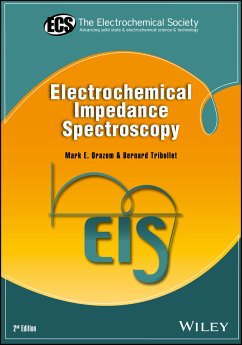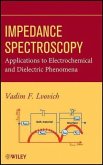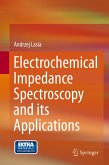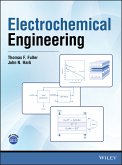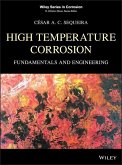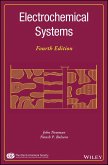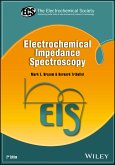

Alle Infos zum eBook verschenken

- Format: PDF
- Merkliste
- Auf die Merkliste
- Bewerten Bewerten
- Teilen
- Produkt teilen
- Produkterinnerung
- Produkterinnerung

Hier können Sie sich einloggen

Bitte loggen Sie sich zunächst in Ihr Kundenkonto ein oder registrieren Sie sich bei bücher.de, um das eBook-Abo tolino select nutzen zu können.
Provides fundamentals needed to apply impedance spectroscopy to a broad range of applications with emphasis on obtaining physically meaningful insights from measurements. * Emphasizes fundamentals applicable to a broad range of applications including corrosion, biomedical devices, semiconductors, batteries, fuel cells, coatings, analytical chemistry, electrocatalysis, materials, and sensors * Provides illustrative examples throughout the text that show how the principles are applied to common impedance problems * New Edition has improved pedagogy, with more than twice the number of examples *…mehr
- Geräte: PC
- mit Kopierschutz
- eBook Hilfe
- Größe: 59.2MB
![Impedance Spectroscopy (eBook, PDF) Impedance Spectroscopy (eBook, PDF)]() Vadim F. LvovichImpedance Spectroscopy (eBook, PDF)110,99 €
Vadim F. LvovichImpedance Spectroscopy (eBook, PDF)110,99 €![Electrochemical Impedance Spectroscopy and its Applications (eBook, PDF) Electrochemical Impedance Spectroscopy and its Applications (eBook, PDF)]() Andrzej LasiaElectrochemical Impedance Spectroscopy and its Applications (eBook, PDF)53,95 €
Andrzej LasiaElectrochemical Impedance Spectroscopy and its Applications (eBook, PDF)53,95 €![Electrochemical Engineering (eBook, PDF) Electrochemical Engineering (eBook, PDF)]() Thomas F. FullerElectrochemical Engineering (eBook, PDF)103,99 €
Thomas F. FullerElectrochemical Engineering (eBook, PDF)103,99 €![High Temperature Corrosion (eBook, PDF) High Temperature Corrosion (eBook, PDF)]() César A. C. SequeiraHigh Temperature Corrosion (eBook, PDF)164,99 €
César A. C. SequeiraHigh Temperature Corrosion (eBook, PDF)164,99 €![Electrochemical Systems (eBook, PDF) Electrochemical Systems (eBook, PDF)]() John NewmanElectrochemical Systems (eBook, PDF)151,99 €
John NewmanElectrochemical Systems (eBook, PDF)151,99 €![Electrochemical Impedance Spectroscopy (eBook, ePUB) Electrochemical Impedance Spectroscopy (eBook, ePUB)]() Mark E. OrazemElectrochemical Impedance Spectroscopy (eBook, ePUB)120,99 €
Mark E. OrazemElectrochemical Impedance Spectroscopy (eBook, ePUB)120,99 €![Student Solutions Manual to accompany Electrochemical Methods (eBook, PDF) Student Solutions Manual to accompany Electrochemical Methods (eBook, PDF)]() Cynthia G. ZoskiStudent Solutions Manual to accompany Electrochemical Methods (eBook, PDF)50,99 €
Cynthia G. ZoskiStudent Solutions Manual to accompany Electrochemical Methods (eBook, PDF)50,99 €-
-
-
Dieser Download kann aus rechtlichen Gründen nur mit Rechnungsadresse in A, B, BG, CY, CZ, D, DK, EW, E, FIN, F, GR, HR, H, IRL, I, LT, L, LR, M, NL, PL, P, R, S, SLO, SK ausgeliefert werden.
- Produktdetails
- Verlag: Polity
- Seitenzahl: 768
- Erscheinungstermin: 10. April 2017
- Englisch
- ISBN-13: 9781119341222
- Artikelnr.: 52556056
- Verlag: Polity
- Seitenzahl: 768
- Erscheinungstermin: 10. April 2017
- Englisch
- ISBN-13: 9781119341222
- Artikelnr.: 52556056
- Herstellerkennzeichnung Die Herstellerinformationen sind derzeit nicht verfügbar.
Preface to the First Edition xix
Acknowledgments xxiii
The Blind Men and the Elephant xxv
A Brief Introduction to Impedance Spectroscopy xxix
History of Impedance Spectroscopy xxxvii
I Background 1
1 Complex Variables 3
1.1 Why Imaginary Numbers? 3
1.2 Terminology 4
1.3 Operations Involving Complex Variables 5
1.4 Elementary Functions of Complex Variables 16
Problems 22
2 Differential Equations 25
2.1 Linear First-Order Differential Equations 25
2.2 Homogeneous Linear Second-Order Differential Equations 29
2.3 Nonhomogeneous Linear Second-Order Differential Equations 32
2.4 Chain Rule for Coordinate Transformations 36
2.5 Partial Differential Equations by Similarity Transformations 38
2.6 Differential Equations with Complex Variables 42
Problems 43
3 Statistics 45
3.1 Definitions 45
3.2 Error Propagation 53
3.3 Hypothesis Tests 59
Problems 70
4 Electrical Circuits 73
4.1 Passive Electrical Circuits 73
4.2 Fundamental Relationships 79
4.3 Nested Circuits 80
4.4 Mathematical Equivalence of Circuits 82
4.5 Graphical Representation of Circuit Response 82
Problems 85
5 Electrochemistry 87
5.1 Resistors and Electrochemical Cells 87
5.2 Polarization Behavior for Electrochemical Systems 90
5.3 Definitions of Potential 106
5.4 Rate Expressions 107
5.5 Transport Processes 111
5.6 Potential Contributions 117
5.7 Capacitance Contributions 120
5.8 Further Reading 124
Problems 125
6 Electrochemical Instrumentation 127
6.1 The Ideal Operational Amplifier 127
6.2 Elements of Electrochemical Instrumentation 129
6.3 Electrochemical Interface 131
Problems 135
II Experimental Considerations 137
7 Experimental Methods 139
7.1 Steady-State Polarization Curves 139
7.2 Transient Response to a Potential Step 140
7.3 Analysis in Frequency Domain 141
7.4 Comparison of Measurement Techniques 154
7.5 Specialized Techniques 155
Problems 160
8 Experimental Design 163
8.1 Cell Design 163
8.2 Experimental Considerations 168
8.3 Instrumentation Parameters 181
Problems 186
III Process Models 187
9 Equivalent Circuit Analogs 189
9.1 General Approach 189
9.2 Current Addition 190
9.3 Potential Addition 196
Problems 201
10 Kinetic Models 203
10.1 General Mathematical Framework 203
10.2 Electrochemical Reactions 205
10.3 Multiple Independent Electrochemical Reactions 218
10.4 Coupled Electrochemical Reactions 221
10.5 Electrochemical and Heterogeneous Chemical Reactions 229
Problems 235
11 Diffusion Impedance 237
11.1 Uniformly Accessible Electrode 238
11.2 Porous Film 239
11.3 Rotating Disk 249
11.4 Submerged Impinging Jet 259
11.5 Rotating Cylinders 262
11.6 Electrode Coated by a Porous Film 264
11.7 Impedance with Homogeneous Chemical Reactions 271
11.8 Dynamic Surface Films 280
Problems 290
12 Impedance of Materials 291
12.1 Electrical Properties of Materials 291
12.2 Dielectric Response in Homogeneous Media 292
12.3 Cole-Cole Relaxation 295
12.4 Geometric Capacitance 295
12.5 Dielectric Response of Insulating Non-Homogenous Media 297
12.6 Mott-Schottky Analysis 298
Problems 305
13 Time-Constant Dispersion 307
13.1 Transmission Line Models 307
13.2 Geometry-Induced Current and Potential Distributions 325
13.3 Electrode Surface Property Distributions 337
13.4 Characteristic Dimension for Frequency Dispersion 358
13.5 Convective Diffusion Impedance at Small Electrodes 359
13.6 Coupled Charging and Faradaic Currents 365
13.7 Exponential Resistivity Distributions 378
Problems 381
14 Constant-Phase Elements 383
14.1 Mathematical Formulation for a CPE 383
14.2 When is a Time-Constant Distribution a CPE? 384
14.3 Origin of Distributions Resulting in a CPE 388
14.4 Approaches for Extracting Physical Properties 389
14.5 Limitations to the Use of the CPE 404
Problems 406
15 Generalized Transfer Functions 409
15.1 Multi-Input/Multi-Output Systems 409
15.2 Transfer Functions Involving Exclusively Electrical Quantities 417
15.3 Transfer Functions Involving Nonelectrical Quantities 422
Problems 429
16 Electrohydrodynamic Impedance 431
16.1 Hydrodynamic Transfer Function 433
16.2 Mass-Transport Transfer Function 436
16.3 Kinetic Transfer Function for Simple Electrochemical Reactions 441
16.4 Interface with a 2-D or 3-D Insulating Phase 442
Problems 454
IV Interpretation Strategies 455
17 Methods for Representing Impedance 457
17.1 Impedance Format 459
17.2 Admittance Format 468
17.3 Complex-Capacitance Format 474
17.4 Effective Capacitance 478
Problems 482
18 Graphical Methods 483
18.1 Based on Nyquist Plots 484
18.2 Based on Bode Plots 491
18.3 Based on Imaginary Part of the Impedance 495
18.4 Based on Dimensionless Frequency 496
18.5 System-Specific Applications 502
18.6 Overview 512
Problems 515
19 Complex Nonlinear Regression 517
19.1 Concept 517
19.2 Objective Functions 519
19.3 Formalism of Regression Strategies 521
19.4 Regression Strategies for Nonlinear Problems 524
19.5 Influence of Data Quality on Regression 527
19.6 Initial Estimates for Regression 533
19.7 Regression Statistics 533
Problems 536
20 Assessing Regression Quality 539
20.1 Methods to Assess Regression Quality 539
20.2 Application of Regression Concepts 540
Problems 555
V Statistical Analysis 557
21 Error Structure of Impedance Measurements 559
21.1 Error Contributions 559
21.2 Stochastic Errors in Impedance Measurements 560
21.3 Bias Errors 566
21.4 Incorporation of Error Structure 570
21.5 Measurement Models for Error Identification 572
Problems 583
22 The Kramers-Kronig Relations 585
22.1 Methods for Application 585
22.2 Mathematical Origin 590
22.3 The Kramers-Kronig in an Expectation Sense 601
Problems 605
VI Overview 607
23 An Integrated Approach to Impedance Spectroscopy 609
23.1 Flowcharts for Regression Analysis 609
23.2 Integration of Measurements, Error Analysis, and Model 610
23.3 Application 613
Problems 619
VII Reference Material 621
A Complex Integrals 623
A.1 Definition of Terms 623
A.2 Cauchy-Riemann Conditions 625
A.3 Complex Integration 627
Problems 633
B Tables of Reference Material 635
C List of Examples 637
List of Symbols 643
References 655
Index 684
Preface to the First Edition xix
Acknowledgments xxiii
The Blind Men and the Elephant xxv
A Brief Introduction to Impedance Spectroscopy xxix
History of Impedance Spectroscopy xxxvii
I Background 1
1 Complex Variables 3
1.1 Why Imaginary Numbers? 3
1.2 Terminology 4
1.3 Operations Involving Complex Variables 5
1.4 Elementary Functions of Complex Variables 16
Problems 22
2 Differential Equations 25
2.1 Linear First-Order Differential Equations 25
2.2 Homogeneous Linear Second-Order Differential Equations 29
2.3 Nonhomogeneous Linear Second-Order Differential Equations 32
2.4 Chain Rule for Coordinate Transformations 36
2.5 Partial Differential Equations by Similarity Transformations 38
2.6 Differential Equations with Complex Variables 42
Problems 43
3 Statistics 45
3.1 Definitions 45
3.2 Error Propagation 53
3.3 Hypothesis Tests 59
Problems 70
4 Electrical Circuits 73
4.1 Passive Electrical Circuits 73
4.2 Fundamental Relationships 79
4.3 Nested Circuits 80
4.4 Mathematical Equivalence of Circuits 82
4.5 Graphical Representation of Circuit Response 82
Problems 85
5 Electrochemistry 87
5.1 Resistors and Electrochemical Cells 87
5.2 Polarization Behavior for Electrochemical Systems 90
5.3 Definitions of Potential 106
5.4 Rate Expressions 107
5.5 Transport Processes 111
5.6 Potential Contributions 117
5.7 Capacitance Contributions 120
5.8 Further Reading 124
Problems 125
6 Electrochemical Instrumentation 127
6.1 The Ideal Operational Amplifier 127
6.2 Elements of Electrochemical Instrumentation 129
6.3 Electrochemical Interface 131
Problems 135
II Experimental Considerations 137
7 Experimental Methods 139
7.1 Steady-State Polarization Curves 139
7.2 Transient Response to a Potential Step 140
7.3 Analysis in Frequency Domain 141
7.4 Comparison of Measurement Techniques 154
7.5 Specialized Techniques 155
Problems 160
8 Experimental Design 163
8.1 Cell Design 163
8.2 Experimental Considerations 168
8.3 Instrumentation Parameters 181
Problems 186
III Process Models 187
9 Equivalent Circuit Analogs 189
9.1 General Approach 189
9.2 Current Addition 190
9.3 Potential Addition 196
Problems 201
10 Kinetic Models 203
10.1 General Mathematical Framework 203
10.2 Electrochemical Reactions 205
10.3 Multiple Independent Electrochemical Reactions 218
10.4 Coupled Electrochemical Reactions 221
10.5 Electrochemical and Heterogeneous Chemical Reactions 229
Problems 235
11 Diffusion Impedance 237
11.1 Uniformly Accessible Electrode 238
11.2 Porous Film 239
11.3 Rotating Disk 249
11.4 Submerged Impinging Jet 259
11.5 Rotating Cylinders 262
11.6 Electrode Coated by a Porous Film 264
11.7 Impedance with Homogeneous Chemical Reactions 271
11.8 Dynamic Surface Films 280
Problems 290
12 Impedance of Materials 291
12.1 Electrical Properties of Materials 291
12.2 Dielectric Response in Homogeneous Media 292
12.3 Cole-Cole Relaxation 295
12.4 Geometric Capacitance 295
12.5 Dielectric Response of Insulating Non-Homogenous Media 297
12.6 Mott-Schottky Analysis 298
Problems 305
13 Time-Constant Dispersion 307
13.1 Transmission Line Models 307
13.2 Geometry-Induced Current and Potential Distributions 325
13.3 Electrode Surface Property Distributions 337
13.4 Characteristic Dimension for Frequency Dispersion 358
13.5 Convective Diffusion Impedance at Small Electrodes 359
13.6 Coupled Charging and Faradaic Currents 365
13.7 Exponential Resistivity Distributions 378
Problems 381
14 Constant-Phase Elements 383
14.1 Mathematical Formulation for a CPE 383
14.2 When is a Time-Constant Distribution a CPE? 384
14.3 Origin of Distributions Resulting in a CPE 388
14.4 Approaches for Extracting Physical Properties 389
14.5 Limitations to the Use of the CPE 404
Problems 406
15 Generalized Transfer Functions 409
15.1 Multi-Input/Multi-Output Systems 409
15.2 Transfer Functions Involving Exclusively Electrical Quantities 417
15.3 Transfer Functions Involving Nonelectrical Quantities 422
Problems 429
16 Electrohydrodynamic Impedance 431
16.1 Hydrodynamic Transfer Function 433
16.2 Mass-Transport Transfer Function 436
16.3 Kinetic Transfer Function for Simple Electrochemical Reactions 441
16.4 Interface with a 2-D or 3-D Insulating Phase 442
Problems 454
IV Interpretation Strategies 455
17 Methods for Representing Impedance 457
17.1 Impedance Format 459
17.2 Admittance Format 468
17.3 Complex-Capacitance Format 474
17.4 Effective Capacitance 478
Problems 482
18 Graphical Methods 483
18.1 Based on Nyquist Plots 484
18.2 Based on Bode Plots 491
18.3 Based on Imaginary Part of the Impedance 495
18.4 Based on Dimensionless Frequency 496
18.5 System-Specific Applications 502
18.6 Overview 512
Problems 515
19 Complex Nonlinear Regression 517
19.1 Concept 517
19.2 Objective Functions 519
19.3 Formalism of Regression Strategies 521
19.4 Regression Strategies for Nonlinear Problems 524
19.5 Influence of Data Quality on Regression 527
19.6 Initial Estimates for Regression 533
19.7 Regression Statistics 533
Problems 536
20 Assessing Regression Quality 539
20.1 Methods to Assess Regression Quality 539
20.2 Application of Regression Concepts 540
Problems 555
V Statistical Analysis 557
21 Error Structure of Impedance Measurements 559
21.1 Error Contributions 559
21.2 Stochastic Errors in Impedance Measurements 560
21.3 Bias Errors 566
21.4 Incorporation of Error Structure 570
21.5 Measurement Models for Error Identification 572
Problems 583
22 The Kramers-Kronig Relations 585
22.1 Methods for Application 585
22.2 Mathematical Origin 590
22.3 The Kramers-Kronig in an Expectation Sense 601
Problems 605
VI Overview 607
23 An Integrated Approach to Impedance Spectroscopy 609
23.1 Flowcharts for Regression Analysis 609
23.2 Integration of Measurements, Error Analysis, and Model 610
23.3 Application 613
Problems 619
VII Reference Material 621
A Complex Integrals 623
A.1 Definition of Terms 623
A.2 Cauchy-Riemann Conditions 625
A.3 Complex Integration 627
Problems 633
B Tables of Reference Material 635
C List of Examples 637
List of Symbols 643
References 655
Index 684
